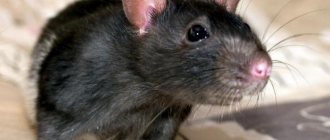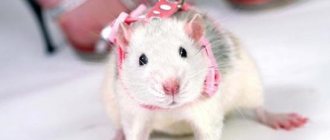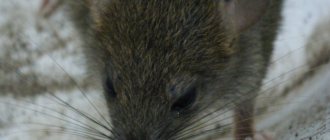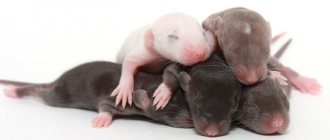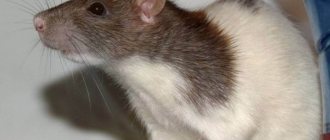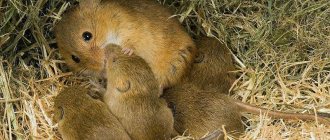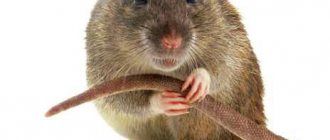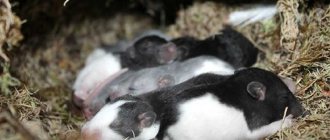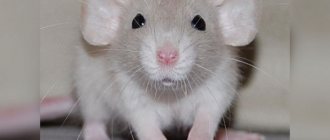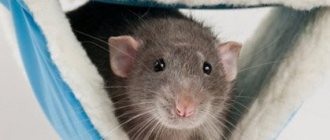Estrus in rats occurs every four to five days, mainly in the evening, and lasts for twelve hours. You may quite often see another female(s) in the cage trying to mount a female in heat (false mating). If you look at her vaginal opening, it will be open, wet and purple in color. If you touch the rear of a rat, it will stretch out, raising its face and rear end into the air, arching its back and vibrating its ears. Theoretically, one pair is enough for breeding, but there is evidence that some rats do not breed in pairs, so 2-3 females per male is recommended.
A rat needs a large nest to give birth. It is usually larger in size than a simple house. Sometimes found on sale in the form of an oblong plastic collapsible vessel with a hole in one of the ends. Although a regular large house made of wood, plywood or plastic will do, the most important thing is to provide the rat with nest building material and not disturb it.
The average litter size is 12 young, but numbers from 1 to 22 are possible. Although the female has only 12 teats, she can care for many more young if she is properly nourished. Most females with very large litters will split their young into two groups and will alternate feeding them, so there is no reason to cull. Finding a home for as many babies as possible should be done before you decide to breed your rats.
Of course, frequent childbirth will not benefit your health, so the recommended period of rest and recovery of the body after finishing feeding the brood is 2-3 months.
Females can become pregnant as early as 5 to 6 weeks of age, but mating is not recommended until they are 3.5 to 4 months old. If they do not produce offspring at this time, they must do so (if you plan to mate them at all) before they are eight months old. If they gave birth between these ages, you can mate them up to one year, but it is not recommended to continue mating after that.
If a female does not bear offspring before eight months, her ability to become pregnant is reduced. If she is overweight, this also reduces her chances of getting pregnant. It is recommended to allow sufficiently strong males to mate, starting from 6 months of age (sometimes another figure is found in the literature - 3 months - however, this is unlikely to be a good idea - approx. Ratsy). Males who have participated in reproduction can mate almost until the end of their lives. If a male has not mated in his youth, he may lose interest in mating altogether.
Pregnancy in rats lasts from 21 to 23 days. The rat will not show its pregnancy until the third week and will not be interested in building a nest until the day of birth or the day before. Pregnancy and breastfeeding require large amounts of nutrients. Good quality dry kitten food, such as Iams and Nutro, will give her extra protein and fat to meet her needs during this time. Make sure she also always has enough of her normal food and water. During birth, the rat will not eat, but it definitely needs access to fresh, clean water, so place the drinking bowl as close to the exit of the nest as possible so that the rat can reach it without going outside. The female's food before and after childbirth must contain calcium. It is recommended to add cottage cheese to your diet.
If you determine that your rat is pregnant, you should add calcium, protein and vitamins to the diet. Prepare the birthing area, shortly before birth, put nesting material in the cage, prepare a place for the male and other females to be deposited. Start searching for future owners of baby rats. If possible, you should not stress a pregnant rat, for example, by introducing a new rat, and also avoid bathing. Because If a rat's pregnancy does not become noticeable immediately, it can be assumed that childbirth will soon take place, so all these measures must be carried out as soon as possible.
The female goes into heat within 36 hours of giving birth and can become pregnant again. It is not good for her if she is feeding her brood at the same time. It is recommended to give the female a rest period of at least two months after finishing her brood to restore her body composition.
It is not recommended to keep two females together if one or both of them have recently given birth to offspring. Although some females co-parent their families without any problems, there are other females who may take over all the young and will try to care for them themselves. These females most often will not allow the mother to approach her cubs. This may not be a problem with small litters, but with a large litter, since such a female will not be able to produce enough milk to feed all the young, many of them may die. There have also been cases where a female went into a rage and killed all the cubs of another female. What to do in this case? The easiest way is to place each female in a separate cage or box before giving birth, so that they take care of their cubs separately. This is a much less stressful option for them.
The cubs must be left with their mother until at least four weeks of age. Large broods may remain for five weeks. They should not stay beyond this time.
The general rule is to separate cubs from their mother by five weeks to avoid the possibility of the mother impregnating the male cub, and separate males from females by six weeks.
It is not advisable to touch rat pups less than 10 days old. After the pups leave the nest on their own, you can touch them freely.
Small, cheerful and intelligent rodents are an excellent choice for a pet. These include hamsters, guinea pigs and. Some pet owners prefer to keep their animals one at a time. Others are interested in when animals have company or simply produce offspring, the characteristics of which can be influenced by choosing females and males. Breeding rats at home can be both an interesting hobby and a small income. But if you decide to start breeding rats and have acquired several animals, then it’s worth understanding all the intricacies of breeding these rodents.
In domestic rats, two types of crossbreeding are possible: selection of different breeds and purebred breeding.
In turn, purebred crossing is divided into the following types:
- Linear crossing;
- Inbreeding;
- Outcrossing;
- Outbreeding.
Linebreeding
Linebreeding or line breeding of rats involves crossing individuals that have a common ancestor. This method allows you to obtain viable offspring with a good genotype. In this case, homozygosity is preserved, and characteristics that do not satisfy the breeder are leveled out.
Inbreeding
To consolidate important breed qualities, the inbreeding method is chosen. Breeding rats in this way involves studying the gene pool and selecting quality sires among close relatives. With close inbreeding, a decrease in the number of viable offspring is possible - so-called inbreeding depression. To reduce the risk of such a situation, individuals for breeding are selected according to strict criteria.
Outcrossing
Outcrossing is used when it is necessary to increase the number of litters with valuable qualities. Mating uses individuals obtained by linebreeding, but without common ancestors in the fourth or fifth generation. To improve the breed, young animals that are unsuitable for a good genetic line are removed from the litter.
Outbreeding
To improve the quality of the breed and the health of the litter, outbreeding is the best option. With such crossing, individuals of a pure breed are selected, but without common ancestors. The disadvantage of this method of breeding is that there is a risk of unplanned characteristics and with frequent use, after several generations the proportions of the animal change.
Despite the different selection options that can be combined, there is still an unpredictable result. This is manifested in the color and length of the coat, the number of individuals in one litter, eye color, and level of health.
Preparation for crossing
For healthy offspring, it is necessary to select a healthy pair of males and females with the necessary breeding characteristics.
Female
In this case, the age of the female, especially the primiparous one, is quite important. Individuals older than five but younger than ten months are suitable for reproduction. Females can become pregnant as early as 5-6 weeks. But it is not recommended to mate earlier than four months of age. If an individual bears offspring during this period, then crossing can be continued for up to a year.
Male
Diet and age affect the sexual activity of males. The appropriate age to start mating is six months. You can continue to mate a male until the end of his life. If a male has not mated at a young age, then his activity may decrease significantly.
How to choose a female and male for breeding
For breeding, a sexually mature healthy pair is formed. You can add 2-3 females to one male, then the fertilization process will be more effective - high-quality, quickly and with several females at once.
The ideal age for the process of first sexual intercourse and childbirth of a female is 4–5 months; males can be taken of any age category. Adults are visually inspected for diseases and placed in a separate cage for future reproduction.
Find out also about the life expectancy of decorative rats.
Nutrition
Breeding rats presupposes a proper diet for rodents. After selecting individuals, it is necessary to adjust their diet in order to remove excess weight and make them more active.
To increase the endurance of a pregnant female, it is necessary to include wheat germ, eggs, fish and poultry in her diet. In this case, you need to exclude strawberries, vegetable oils, bell peppers and boiled liver from your diet.
Clean and fresh water in the drinking bowl is a vital element in the diet of ornamental rats, especially during the mating period. In addition, it is recommended to place the animals in a separate spacious cage for free movement.
Pairing
It is necessary to replant the male during the period of estrus. It occurs in females in the interval from four to ten days and lasts up to one day. During this period, the behavior of the individual changes. False matings can be observed when other females try to mount a female in heat. In such a female, the appearance of the vaginal opening changes - it acquires a purple tint, becomes open and wet. If you touch such an individual from above, it begins to arch its back and vibrate its ears.
Typically, rats need one male and one female to breed. But there are cases when mating occurs only when two or three females move in with the male. After birth, it is necessary to remove the male from the cage to avoid re-fertilization, because estrus is restored 36 hours after the birth of the brood.
Pregnancy can be tracked by the absence of estrus after a certain period of time. The abdomen enlarges after two to three weeks.
At what age do they begin to reproduce?
The optimal age for these rodents to begin breeding is 4–5 months. At this time, they reach sexual maturity and are able to have healthy offspring. In females at the age of 6–8 months, the pelvis may narrow, after which they are unable to give birth on their own. In this case, a caesarean section is used, after which the female is discarded, as she will no longer be able to give birth on her own.
Repeated fertilization is possible 3-4 weeks after the end of feeding the babies of the previous offspring. And males are ready for sexual intercourse always and at any age, and can begin to mate even in adolescence.
Rats in heat
Estrus in females occurs every 6–8 days and lasts about 12–14 hours. At this time, the animal behaves nervously, constantly moving, often chaotically. The rodent's labia swell from the rush of blood, which causes unpleasant sensations in the form of itching. In addition, mucous discharge appears.
Did you know? Rats in their normal state are able to jump to a height of 80 cm, and during stress they can “fly up” two meters.
The behavior of young females (2–3 months old), which imitate sexual intercourse, is interesting. It is believed that these caresses have no special connection with erotic attraction to another individual of the same sex. Most likely, this is “friendly support”, when another female imitates the male’s attack by touching the “partner’s” back, which brings pleasure and orgasm.
Pet rat pregnancy
The duration of pregnancy in decorative rats ranges from 20 to 24 days. The first two weeks of pregnancy will not be noticeable - the rat does not show its condition in any way and only begins to build a nest closer to the birth.
As soon as you suspect that an individual is pregnant, you need to expand her diet to include apples, poultry and fish, cottage cheese, and nettles. Products containing protein, calcium and vitamins must be present. You should exclude grapes, lettuce, garlic, onions, tomatoes and egg yolks from your diet.
To replenish fluid there must be clean, preferably spring water. Closer to birth, you need to prepare the nest. Zoological stores sell ready-made options in the form of plastic or wooden houses larger than usual for rodents. You also need to provide the female with building material in the form of unpainted paper and pieces of natural fabric.
Breeding rats at home requires the breeder to be extremely careful and careful. Stress factors should be avoided throughout pregnancy. Such, for example, as introducing new animals into a cage and moving the female to another place.
Birth of the brood
Throughout the entire period of childbirth, the female should be in silence, darkness and peace. Otherwise, labor may be disrupted. If the pregnancy proceeded normally, the individual is healthy, then an uncomplicated birth lasts for an hour to an hour and a half. There can be from eight to fifteen rat pups in a litter.
After giving birth, you should not disturb the nursing individual, at least until the tenth day, when the young will leave the nest on their own.
It is worth avoiding cases when there are two females with cubs in a cage. They can be aggressive to the point of eating the brood of another individual.
After giving birth, the female must have a varied diet and water. Often, lack of water can cause a mother to eat her litter. After 5 weeks, the cubs must be separated from their mother to prevent the mother from fertilizing her sons. 6 weeks after birth, you need to separate yourself and the males in the litter separately.
How many pups are born in a litter?
The usual number of litters for the first time is up to 12 pups - according to the number of nipples of their mother. However, anomalies also occur when a female can give birth to from 1 to 22 babies. At the same time, cubs can be born as all viable or partially dead offspring. There is a high probability of death of rat pups due to lack of nutrition (lack of free nipples).
If the number of newborns is more than 12, the female is able to feed them, but in this case it is necessary to provide her with high-calorie nutrition and create conditions for rest between feedings. You also need to pay attention to the nest - enlarge it, insulate it. In good conditions, the rat will feed the babies in two “shifts”, then there will be no need to cull them.
Young ornamental rats
Rat cubs are born with closed ears, blind, shortened tails, underdeveloped limbs and no hair. Their weight is four to six grams. For the first weeks, the pups depend on their mother. For full growth and development, it is vital for them to satisfy the sucking reflex.
3-4 days after birth, the ears open. On the sixth day, the first fur is formed. Teeth erupt after 8-10 days.
Only after two weeks the eyes open. At the same time, the sex of the baby rats can be determined. Females have small nipples.
After eighteen days, the coat becomes thicker. The animals show more independence and may attempt to eat solid food.
After three weeks, the pups are independent enough to clean their own fur and eat adult food.
The young develop throughout the year. Their growth is significantly influenced by their diet - it must be rich in proteins to fully build bones and muscle mass.
Read also
Pairing
Mating On the 2nd day after the first signs of the cat’s readiness to mate appear, you need to contact the owner of the breeder and agree on the possibility of delivering the cat to him. The animal should be transported in a special basket or container-basket for transportation
Sexual cycles
Sexual cycles Bitches have sexual cycles 2 times a year. Males retain the ability to reproduce throughout the year. There are 3 phases of the reproductive cycle in females. The 1st phase is the precursor, or proestrum. The period lasts on average 5–8 days. At this time the dog becomes
Pairing
Mating On the second day after the first signs of the cat's readiness to mate appear, the cat owner must contact the owner of the manufacturer and agree on the possibility of delivering his pet to him. The animal should be transported in a cat basket.
Pairing
Mating On the second day after the first signs of the cat's readiness to mate appear, the cat owner must contact the owner of the manufacturer and agree on the possibility of delivering his pet to him. The animal should be transported in a cat basket.
Sexual cycles
Sexual cycles Sexual cycles in females occur 2 times a year, males retain the ability to reproduce throughout the year. Females have 3 phases of the sexual cycle:? forerunner (proestrum). Lasts on average 5–8 days. During this period, the dog becomes restless and has
Pairing
Mating Under favorable conditions, guinea pigs can produce offspring at any time of the year. To exclude unscheduled reproduction when keeping one pair of animals, they are placed in different cages, placing the female with the male only for mating.
Pairing
Mating On the second day after the first signs of the cat's readiness to mate appear, the cat owner must contact the owner of the manufacturer and agree on the possibility of delivering his pet to him. The animal should be transported in a cat basket.
Sexual cycles and the cat's readiness to reproduce
Sexual cycles and the cat’s readiness for reproduction In domestic cats, there is no dependence of the timing of bearing offspring on the length of daylight hours and the season, in contrast to stray, feral animals, in which a clear dependence of the readiness period has been revealed
Preparing the cat. Pairing
Preparing the cat. Mating On the second day after the first signs of the cat's readiness to mate appear, you should contact the owner of the breeder and agree on the possibility of delivering your cat to him. The animal should be transported in a transportation basket
Sexual cycles
Sexual cycles Decorative mice can breed at home almost all year round. The winter pause in reproduction, which is observed in most animals, is absent in these animals. Fluctuations in sexual activity may depend to some extent on
PAIRING
MATING In the conditions of Central Russia, the most convenient time to start mating is the end of March - the beginning of April. In the south of the country, mating begins 2–3 weeks earlier, and in the north, on the contrary, later. When mating after the beginning of July, the pigeons do not have time to molt until
Pairing
Mating 2–3 months before mating, it is recommended to separate the pigeons and doves and keep them separately. This measure will help the pigeons gain strength for the upcoming breeding. In central Russia, pigeons begin mating, as a rule, in late March - early
Sexual cycles and the cat's readiness to reproduce
Sexual cycles and the cat’s readiness for reproduction In domestic cats, there is no dependence of the timing of bearing offspring on the length of daylight hours and the season, in contrast to stray, feral animals, in which a clear dependence of the readiness period has been revealed
Preparing the cat. Pairing
Preparing the cat. Mating On the second day after the first signs of the cat's readiness to mate appear, you should contact the owner of the breeder and agree on the possibility of delivering your cat to him. The animal should be transported in a transportation basket
Artificial feeding
In some cases, when the female dies after giving birth or refuses to breastfeed, you can try to feed the cubs to the child's family. Insulin syringes are used for this. Infant formula is taken in the proportion of 1 part to 50 ml of condensed milk with a high fat content of up to 12%, including half a tablet of calcium gluconate. It is acceptable to use milk replacers for cats or dogs.
Feeding should be done frequently with gradually increasing portions. It is preferable to give such cubs to another lactating female if she accepts them.
In conclusion, it should be said that breeding rats is quite a fascinating process, but do not forget that by crossing different species you can create something completely unusual.
The ability of rats to reproduce quickly and productively is amazing. Of course, rats in the wild are not so numerous, but the number of gray rats (pasyuks) living in the anthropogenic environment is countless. There are almost twice as many of these rodents as there are humans, making rats the predominant mammal species on planet Earth. In nature, they breed mainly during the warm period (mating peaks are spring, autumn), but in heated rooms, rats can breed at any time of the year. The latter also applies to our pets.
Rats are ripe for breeding
very quickly (at the age of 30-50 days), with females becoming “adults” faster. Estrus (estrus) in a rat occurs every 6-8 days and lasts 13-14 hours (usually early in the morning or between 16.00 and 22.00). At the same time, the female behaves nervously, her labia swell and become covered with mucous secretions.
Male mates
with the female from 15 to 70 times in 15-20 minutes. After fertilization, the female develops a so-called vaginal or inguinal “plug” - an external sign of successful copulation. The “plug” is a specific evidence of paternity; it is needed to protect against fertilization by another male. Usually, after a day, the “vaginal plug” disappears.
Pregnancy
in rats lasts 21-24 days, during which time the female gains 20-30 g in weight. Around the 13th day, pregnancy becomes noticeable, as the rat's body becomes noticeably rounder and the nipples become enlarged. It should be borne in mind that due to mating without fertilization, “imaginary pregnancy” also occurs in rats. It lasts approximately 12-14 days, during which the female stops estrus and maternal instincts emerge - the rat builds a nest and avoids the male.
During pregnancy, it is necessary for the female to have the opportunity to build a nest
or set up an artificial house to keep the little ones warm. To do this, there must be enough soft material in the cage (paper, fabric, soft hay).
About the beginning of contractions
indicates that the rat is lying down. Childbirth lasts several hours (1-4), usually at night. A rat litter can have from 1 to 20 pups, but on average the number of newborns is 8-12. Babies come into the world naked, blind and deaf, but rather squeaky; weigh 4-6 g. The number and size of rat pups depend on various factors: the age and strength of the mother, the quality of food, living conditions, the number of previous litters of the female, etc. After giving birth, the rat eats the umbilical cord. She also eats stillborn cubs, and sometimes some of the living ones. The latter may be a consequence of very numerous offspring or a sense of danger in the rat.
After 18 hours after giving birth, the female begins postpartum estrus
, during which the male can cover her. As a result, pregnancy is possible, which can last longer than normal (up to 34 days).
The rat keeps its children warm - it puts them in one pile and covers them with its body. The female not only constantly licks the baby rats, but also maintains cleanliness in the nest (she goes to the toilet strictly outside of it). The rat guards its offspring with great fear, so if something alarms it, it can drag the children to another place (the female carries small rat pups in her teeth, clasping them across the body). This is not good for them, because babies get cold during transfer, so it is important not to disturb the mother who gave birth.
Rat milk is very nutritious - it contains more than 8% protein, 9% fat, 4% lactose. That's why babies develop
quickly: in 3-4 days their ears open, after 8-10 - teeth (incisors) erupt and the ability to crawl appears, after 13-17 days - their eyes open, and the edge appears. At 3-4 weeks, the pups become independent. At this time, they still have childlike body proportions and a short muzzle, so the little rats look especially cute.
Estrus in rats proceeds according to certain rules, which the owner must know so as not to confuse the pathological condition with it - bleeding, which can be fatal for the animal.
Ratmaniya
For some reason, people constantly strive to breed, breed, or breed their animals, be it a cat, a rabbit or a rat. Regularly, here and there, strikingly similar, carbon-copy questions pop up: “I’m looking for a male/female so that I can have children,” “I’m looking for a groom for a rat, I want Masiks,” “I have a male and a female, how should I bring them together in order to get baby rats” and phrases like: “I want the female to feel the joy of motherhood”, “they also need to do THIS”, “I want to continue the family of my rat, she is so good”, “I want offspring”, “the female will live longer.” And the questions of such unlucky owners, and their answers to the question “why?” they say that they thought little and had practically no understanding of what they wanted to do. What awaits you if you decide to breed rats?
Childbirth does not add health!
They do not prolong life, do not reduce the risk of diseases of the reproductive organs (ovaries, uterus) and do not exclude the possibility of breast tumors. On the contrary, childbirth can aggravate existing health problems and the female can die thanks to your “experiments” with her life. Yes, this is an extreme case and does not happen to every female, but who guarantees that your beloved rat will not have to lose his life due to a pathological pregnancy or unsuccessful birth (a rat pup stuck in the birth canal, bleeding)? Who guarantees that she will not become one of those females who had to be rushed to the veterinary clinic for a caesarean section and the removal of decaying fetuses that were poisoning her body, or because the rat was unable to give birth? Despite the fact that the cost of the procedure is not low (1-3 thousand rubles), outside of large cities it is almost impossible to find a veterinarian who will agree and be able to operate on a rat, and no one can guarantee that your rat will survive after the operation. Who guarantees that your beloved rat will not undermine his health during childbirth and the exhausting five-week feeding of rat pups, of which, in extreme cases, there may be 15-20 pieces, and will not begin to constantly get sick (and this often happens exactly like this)?
